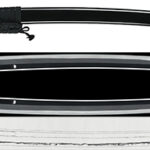Ordering number:AS24290
Katana in Koshirae (NBTHK Hozon Token)
Signature: Mumei (attributed to Chiyozuru).
無銘(千代鶴)
We divide four sections for each sword as Saijyo Saku, Jyojyo Saku, Jyo Saku, and Regular Saku.
This work is ranked as Jyo Saku for a mumei blade attributed to Chiyozuru.
Habaki: Made of plain copper.
Blade Length: 68.0 cm (26.77 in).
Curvature: 2.0 cm (0.79 in).
Mekugi Hole: 3.
Width at Base (Motohaba): 3.19 cm (1.26 in).
Width at Tip (Sakihaba): 2.15 cm (0.85 in).
Thickness (Kasane): 0.67 cm (0.26 in).
Sword Weight: 640 g (1.41 lbs).
Era: Nanbokucho Period (Bunwa era) to early Muromachi Period.
Shape: Deep curvature with a long kissaki, and bohi (grooves) carved on both sides.
Jigane: Beautifully refined ko-itame hada with ji-nie and a clear, vibrant jigane. Utsuri is visible.
Hamon: Nie-deki suguha mixed with a gentle downward curve. Features bohi carved on both sides and a long boshi.
Features: The name "Chiyozuru" originates from Kuni Yasu, the progenitor of the Echizen Rai lineage, who was also known as Chiyozuru-maru in his youth. The first-generation Kuni Yasu, a descendant of the Rai School, moved to Echizen Province and settled in what is now Takefu City or Tsuruga City in Fukui Prefecture. Signed works are limited to two generations of Kuni Yasu and his descendants, Morishige and Morihiro. The contemporary kin of Kuni Yasu included Shigekuni and Kuni Yuki.
Koshirae:
Saya: Black lacquered.
Tsuba: Oval iron tsuba (tate-maru shape).
Fuchi: Shakudo with a high-relief landscape and gold inlay.
Kashira: Pinecone motif carved in high relief with gold inlay.
Menuki: Shakudo with hollyhock leaves carved in high relief and gold inlay.
Aoi Art’s Comment:
Chiyozuru works have long been considered auspicious and have been highly regarded for ceremonial occasions. Historically, they were often presented as gifts for celebratory events, such as samurai achievements or the birth of a daimyo’s child. Known as "Echizen Rai," the first generation Chiyozuru Kuni Yasu thrived during the Nanbokucho Period. This blade is believed to date to the early Muromachi Period and has been certified with NBTHK Hozon Token status. With deep curvature and utsuri visible, it exemplifies the quality of Chiyozuru's work. The koshirae, while understated, complements the blade beautifully.
NBTHK Hozon Token
Aoi Art estimation paper.
Whole oshigata.
Auction Starting Price:600,000JPY
Place Bid
Related Items:
 Dai Sho : Motohira(Dai Sho:NBTHK Tokubetsu Hozon Token)(Daisho Koshirae: NBTHK Tokubetsu Hozon Tosogu)
Dai Sho : Motohira(Dai Sho:NBTHK Tokubetsu Hozon Token)(Daisho Koshirae: NBTHK Tokubetsu Hozon Tosogu)
 Katana: Mumei (attributed to Den Rai Kunitoshi)(NBTHK 37th Juyo Token)
Katana: Mumei (attributed to Den Rai Kunitoshi)(NBTHK 37th Juyo Token)
 Katana :(Kiku Mon) Takai Echizen Kami Minamoto Rai Nobuyoshi (NBTHK Tokubetsu Hozon Token)
Katana :(Kiku Mon) Takai Echizen Kami Minamoto Rai Nobuyoshi (NBTHK Tokubetsu Hozon Token)
 Katana: Oite Nanki Shigekuni Zo Kore(Shodai)(NBTHK Tokubetsu Hozon Token)(Consignment Sale)
Katana: Oite Nanki Shigekuni Zo Kore(Shodai)(NBTHK Tokubetsu Hozon Token)(Consignment Sale)
 Katana: Hizen Koku Tadayoshi (8th generation)(NBTHK Tokubetsu Hozon Token)
Katana: Hizen Koku Tadayoshi (8th generation)(NBTHK Tokubetsu Hozon Token)
 Katana: Mumei(Unsigned)(Aoe school)(54th NBTHK Juyo Token)
Katana: Mumei(Unsigned)(Aoe school)(54th NBTHK Juyo Token)







